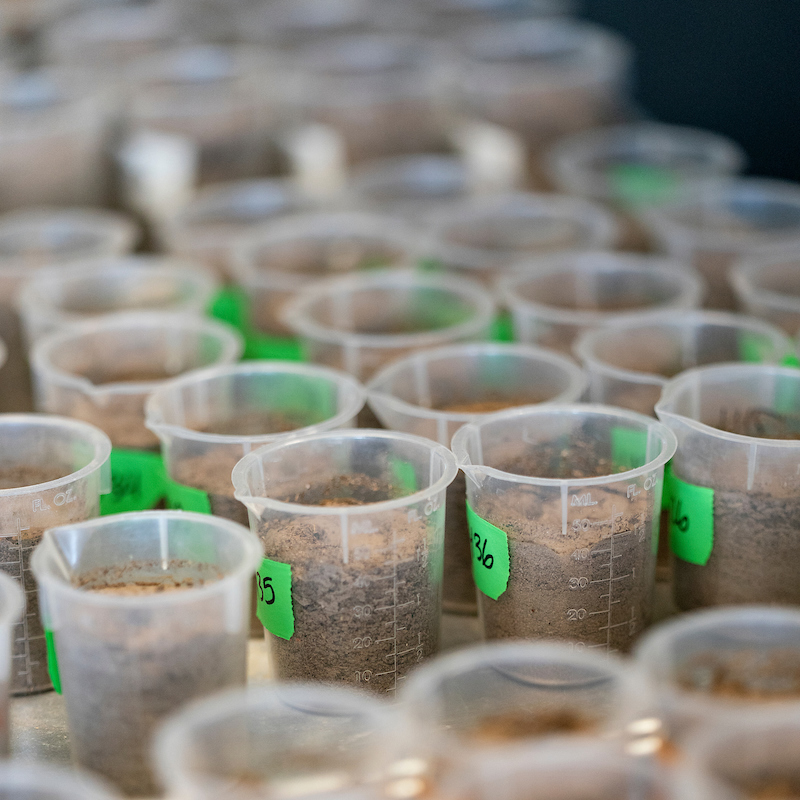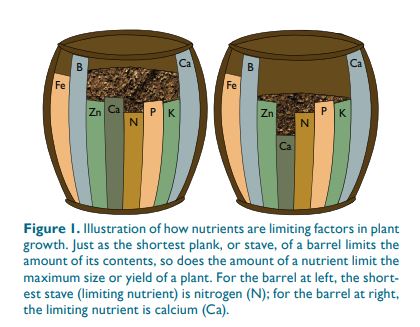Essential Nutrients for Plants
By: Tony L. Provin and Mark L. McFarland


To be able to grow, develop, and produce at their best, plants must have specific elements or compounds called plant essential nutrients.
A plant that lacks an essential nutrient cannot complete its life cycle — the seed may not germinate; the plant may not be able to develop roots, stems, leaves, or flowers properly; or it may not be able to produce seeds to create new plants. Often the plant itself will die.
However, having too much of a nutrient can harm and even kill plants. For example, having too much nitrogen can cause a plant to grow more leaves but less or no fruit. Too much manganese can make the leaves turn yellow and eventually die. And excess boron can kill a plant.
You can save money and effort — and even your plants — if you know what and how much to give your plants. The plants will be healthier and more productive if you give them what they need — no more and no less.
Plant essential nutrients
Scientists have identified 16 essential nutrients and grouped them according to the relative amount of each that plants need:
- Primary nutrients, also known as macronutrients, are those usually required in the largest amounts. They are carbon, hydrogen, nitrogen, oxygen, phosphorus, and potassium.
- Secondary nutrients are those usually needed in moderate amounts compared to the primary essential nutrients. The secondary nutrients are calcium, magnesium, and sulfur.
- Micro- or trace nutrients are required in tiny amounts compared to primary or secondary nutrients. Micronutrients are boron, chlorine, copper, iron, manganese, molybdenum, and zinc.
A very few plants need five other nutrients: cobalt, nickel, silicon, sodium, and vanadium.
Each essential nutrient affects specific functions of plant growth and development (Table 1). Plant growth is limited by the nutrient that is in the shortest supply (Fig. 1).
Forms of essential plant nutrients
To be used by a plant, an essential nutrient must be broken down into its basic form. The nutrient must be in the form of either a positively charged ion (cation) or a negatively charged ion (anion). A plant cannot use organic compounds, such as those in manure or dead leaves, until they are broken down into their elemental or ionic forms.
Also, plants cannot use an element that is not in the proper form (a specific ion) even if it is present in high concentrations in the soil. For example, the presence of iron (Fe) in the soil will not guarantee that enough of the proper iron ions, Fe2+ or Fe3+, will be available to the plant.
Plants take in almost all of the essential nutrients through their roots. The exception is carbon, which is taken in through leaf pores, or stomata.
Two types of organisms living in the soil help the roots take up nutrients:
- Microorganisms, or microbes, break down organic compounds into inorganic compounds in a process called mineralization.
- Fungi enable some plants to take up phosphorus by increasing the size of the roots and providing more soil-to-root contact.
Determining available nutrient levels in the soil
It is hard to tell whether the soil has a nutrient problem just by looking at the plants. Symptoms vary by nutrient and plant species.
Common symptoms of a soil nutrient problem include:
- Little or no growth
- Dead tissue at the leaf tips, on the leaf edges, or within the leaves
- Yellow or dead leaves on one part of the plant only
- Overall leaf yellowing, yellow streaks, or white between the leaf veins
Before spreading any fertilizer — organic or inorganic — check for other possible causes of the problem. Similar symptoms can be caused by diseases, insects, herbicides, compacted soil, and wide changes in soil moisture levels.
To learn whether you need to add nutrients, have the soil tested by an agricultural soil testing laboratory such as the Texas A&M AgriLife Extension Service Soil, Water and Forage Testing Laboratory. The test results will enable you to apply or avoid applying specific nutrients to ensure that the plants get what they need.
Table 1. Form, source, mode of uptake and major functions of 16 plant essential nutrients
| Nutrient Family | Nutrient | Percentage of plant | Form taken up by plant (ion) | Mode of uptake | Major functions in plants |
|---|---|---|---|---|---|
| Primary | Carbon | 45 | Carbon dioxide (CO2), bicarbonate (HCO3) | Open somates | Plant structures |
| Primary | Oxygen | 45 | Water (H2O) | Mass flow | Respiration, energy production, plant structures |
| Primary | Hydrogen | 6.0 | Water (H2O) | Mass flow | pH regulation, water retention, synthesis of carbohydrates |
| Primary | Nitrogen | 1.75 | Nitrate (NO3), ammonium (NH4+) | Mass flow | Protein/amino acids, chlorophyll, cell formation |
| Primary | Phosphorous | 0.25 | Dihydrogen phosphate (H2PO4-, HPO42-), phosphate (PO43+) | Root interception | Cell formation, protein syntheses, fat and carbohydrate metabolism |
| Primary | Potassium | 1.5 | Potassium ion (K+) | Mass flow | Water regulation, enzyme activity |
| Secondary | Calcium | 0.50 | Calcium ion (Ca2+) | Mass flow | Root permeability, enzyme activity |
| Secondary | Magnesium | 0.20 | Magnesium ion (Mg2+) | Mass flow | Chlorophyll, fat formation and metabolism |
| Secondary | Sulfur | 0.03 | Sulfate (SO42-) | Mass flow | Protein, amino acid, vitamin and oil formation |
| Micro | Chlorine | 0.01 | Choloride (Cl-) | Root interception | Chlorophyll formation, enzyme activity, cellular development |
| Micro | Iron | 0.01 | Iron ion (Fe2+, Fe3+) | Root interception | Enzyme development and activity |
| Micro | Zinc | 0.002 | Zinc ion (Zn2+) | Root interception | Enzyme activity |
| Micro | Manganese | 0.005 | Manganese ion (Mn2+) | Root interception | Enzyme activity and pigmentation |
| Micro | Boron | 0.0001 | Boric acid (H3BO3), borate (BO33-), tetraborate (B4O7) | Root interception | Enzyme activity |
| Micro | Copper | 0.0001 | Copper ion (Cu2+) | Mass flow | Enzyme activity |
| Micro | Molybdenum | 0.00001 | Molybdenum ions (HMoO4-, MoO42+) | Mass flow | Enzyme activity and nitrogen fixation in legumes |
Download a printer-friendly version of this publication: Essential Nutrients for Plants (pdf)
